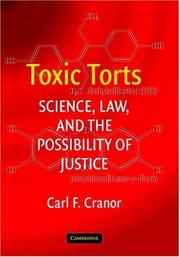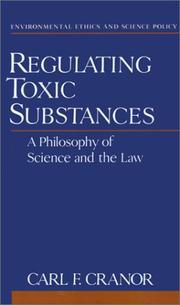| Listing 1 - 6 of 6 |
Sort by
|
Book
ISBN: 9780674049703 Year: 2011 Publisher: Cambridge, Mass. Harvard University Press
Abstract | Keywords | Export | Availability | Bookmark
 Loading...
Loading...Choose an application
- Reference Manager
- EndNote
- RefWorks (Direct export to RefWorks)
Hygiene. Public health. Protection --- Toxicology --- Environmental health --- Environmental toxicology. --- Pollution --- Environmental Pollutants --- Environmental Exposure --- Environmental Pollution --- Public Health --- Government policy --- Law and legislation --- adverse effects. --- toxicity. --- legislation & jurisprudence.
Book
ISBN: 0674058925 9780674058927 9780674049703 0674049705 0674262840 Year: 2011 Publisher: Cambridge, Mass. Harvard University Press
Abstract | Keywords | Export | Availability | Bookmark
 Loading...
Loading...Choose an application
- Reference Manager
- EndNote
- RefWorks (Direct export to RefWorks)
Take a random walk through your life and you'll find it is awash in industrial, often toxic, chemicals. Sip water from a plastic bottle and ingest bisphenol A. Prepare dinner in a non-stick frying pan or wear a layer of Gore-Tex only to be exposed to perfluorinated compounds. Hang curtains, clip your baby into a car seat, watch television-all are manufactured with brominated flame-retardants. Cosmetic ingredients, industrial chemicals, pesticides, and other compounds enter our bodies and remain briefly or permanently. Far too many suspected toxic hazards are unleashed every day that affect the development and function of our brain, immune system, reproductive organs, or hormones. But no public health law requires product testing of most chemical compounds before they enter the market. If products are deemed dangerous, toxicants must be forcibly reduced or removed-but only after harm has been done. In this scientifically rigorous legal analysis, Carl Cranor argues that just as pharmaceuticals and pesticides cannot be sold without pre-market testing, other chemical products should be subject to the same safety measures. Cranor shows, in terrifying detail, what risks we run, and that it is entirely possible to design a less dangerous commercial world.
Environmental health --- Environmental toxicology. --- Pollution --- Ecotoxicology --- Pollutants --- Toxicology --- Environmental quality --- Health --- Health ecology --- Public health --- Environmental engineering --- Health risk assessment --- Government policy --- Law and legislation --- Health aspects --- Environmental aspects

ISBN: 1107168325 1280703598 0511246234 0511246927 0511244770 0511318065 0511617712 0511245521 9780511246234 9780511246920 9780511244773 9780511617713 0521728401 9780521728409 0521861829 9780521861823 0521861829 9780521861823 9780521728409 Year: 2006 Publisher: Cambridge : Cambridge University Press,
Abstract | Keywords | Export | Availability | Bookmark
 Loading...
Loading...Choose an application
- Reference Manager
- EndNote
- RefWorks (Direct export to RefWorks)
The relationship between science, law and justice has become a pressing issue with US Supreme Court decisions beginning with Daubert v. Merrell-Dow Pharmaceutical. How courts review scientific testimony and its foundation before trial can substantially affect the possibility of justice for persons wrongfully injured by exposure to toxic substances. If courts do not review scientific testimony, they will deny one of the parties the possibility of justice. Even if courts review evidence well, the fact and perception of greater judicial scrutiny increases litigation costs and attorney screening of clients. Mistaken review of scientific evidence can decrease citizen access to the law, increase unfortunate incentives for firms not to test their products, lower deterrence for wrongful conduct and harmful products, and decrease the possibility of justice for citizens injured by toxic substances. This book introduces these issues, reveals the relationships that pose problems, and shows how justice can be denied.
Toxic torts --- Hazardous substances --- Chemicals --- Law and legislation --- United States. --- Law --- General and Others
Book
ISBN: 1316792919 1316585360 1316789551 1107151961 1316606384 Year: 2016 Publisher: New York : Cambridge University Press,
Abstract | Keywords | Export | Availability | Bookmark
 Loading...
Loading...Choose an application
- Reference Manager
- EndNote
- RefWorks (Direct export to RefWorks)
US tort law, cloaked behind increased judicial review of science, is changing before our eyes yet we cannot see it. While Supreme Court decisions have altered how courts review scientific testimony, the complexity of both science and legal procedures mask the resulting social consequences. Yet these consequences are too important to remain hidden. Mistaken court reviews of scientific evidence can decrease citizen access to the law, decrease incentives for firms to test their products, lower deterrence for harmful products, and decrease the possibility of justice for citizens injured by toxic substances. Even if courts review evidence well, increases in litigation costs and attorney screening of clients can impede access to the law. Newly revised and expanded, Toxic Torts, 2nd edition introduces these issues, reveals the relationships that can deny citizens just restitution for harms suffered, and shows how justice can be improved in toxic tort cases.
Toxic torts --- Hazardous substances --- Chemicals --- Law - U.S. - General --- Law - U.S. --- Law, Politics & Government --- Chemical compounds --- Compounds, Chemical --- Chemistry --- Hazardous substances damages, Liability for --- Liability for hazardous substances damages --- Liability for toxic substances damages --- Torts, Toxic --- Toxic substances damages, Liability for --- Personal injuries --- Law and legislation

ISBN: 019507436X Year: 1993 Publisher: New York (N.Y.) : Oxford university press,
Abstract | Keywords | Export | Availability | Bookmark
 Loading...
Loading...Choose an application
- Reference Manager
- EndNote
- RefWorks (Direct export to RefWorks)
Chemicals --- Hazardous substances --- Industrial safety --- Law and legislation --- Law and legislation --- Law and legislation
Book

ISBN: 0674071093 0674067762 9780674067769 9780674064461 0674064461 Year: 2013 Publisher: Cambridge, MA
Abstract | Keywords | Export | Availability | Bookmark
 Loading...
Loading...Choose an application
- Reference Manager
- EndNote
- RefWorks (Direct export to RefWorks)
Can genes determine which fifty-year-old will succumb to Alzheimer's, which citizen will turn out on voting day, and which child will be marked for a life of crime? Yes, according to the Internet, a few scientific studies, and some in the biotechnology industry who should know better. Sheldon Krimsky and Jeremy Gruber gather a team of genetic experts to argue that treating genes as the holy grail of our physical being is a patently unscientific endeavor. Genetic Explanations urges us to replace our faith in genetic determinism with scientific knowledge about how DNA actually contributes to human development. The concept of the gene has been steadily revised since Watson and Crick discovered the structure of the DNA molecule in 1953. No longer viewed by scientists as the cell's fixed set of master molecules, genes and DNA are seen as a dynamic script that is ad-libbed at each stage of development. Rather than an autonomous predictor of disease, the DNA we inherit interacts continuously with the environment and functions differently as we age. What our parents hand down to us is just the beginning. Emphasizing relatively new understandings of genetic plasticity and epigenetic inheritance, the authors put into a broad developmental context the role genes are known to play in disease, behavior, evolution, and cognition. Rather than dismissing genetic reductionism out of hand, Krimsky and Gruber ask why it persists despite opposing scientific evidence, how it influences attitudes about human behavior, and how it figures in the politics of research funding.
Genetics. --- Biology --- Embryology --- Mendel's law --- Adaptation (Biology) --- Breeding --- Chromosomes --- Heredity --- Mutation (Biology) --- Variation (Biology) --- Genetic Determinism. --- Genetic Phenomena. --- Interdisciplinary Communication.
| Listing 1 - 6 of 6 |
Sort by
|

 Search
Search Feedback
Feedback About
About Help
Help News
News